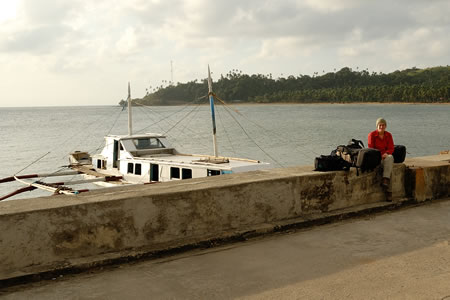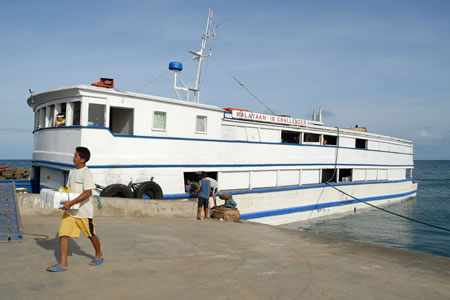English | Dutch |
|
| We survived it again | |
Magdiwan (Philippines), December 20th 2008 |
|
We had a very bad night’s rest. That is something you can expect when your hotel is located near a videoke-bar. At the time the bar closed its doors at around 03.00 hours in the morning, the first people were already on their way to the harbour to catch the ferry of six o’clock. The upcoming departure of the ferry was several times announced by the huge ship’s horn that must have waked the complete population of San Augustin village, including us. Our own alarm clock went of at 7 o’clock. We leave the hotel at 07.15 am and set off for the harbour. Today we take in two stages the ferry to the island of Sibuyan. Sibuyan, together with the other islands of Romblon and Tablas (on where the village of San Augustin is located) form together the Romblon Island group. This island group receives few travellers which make it perfectly suitable to experience the Filipino life outside the more travelled areas. When we arrive at the pier, we see that a ‘bangka’ will bring us for the first stage from Tablas Island to Romblon Island. A bangka is a small and narrow boat that can transport approximately 50-60 passengers. On both the right and left side of the boat, a bamboo or wooden outrigger is constructed to give the boat more stability on the sea. The cabin in where the passengers sit down is small and very basic. The cabin has around ten planks that serve as benches. Every plank can take five passengers. The other passengers must try to find a place on the luggage between the benches, or of course on the roof of the cabin. Doors are not available in this bangka, so people and their luggage must try to reach their seat by crawling through the windows. |
|
 |
|
Ivonne is posing with the bangka that brought us to Romblon |
|
Around 08.00 am, the bangka leaves the harbour for the normally one hour journey to Romblon town. As long as we are still navigating in the bay of San Augustin, the ride is comfortable, but as soon as we reach the open sea, the situation changes. The sea is rough and the boat is swung by the waves. The passengers close the windows with wooden partitions to prevent that waves come into the boat. Because of that, the cabin becomes pitch-dark which aggravates the nervous atmosphere in the cabin. The wooden partitions are shabby, which means that once in a while people are splashed by sea water that comes through the holes and chinks. Next to us sits a woman with her little son. The woman is so terrified that she prays many times, often has her hands before her eyes and travels the remaining time with her fingers in her ears. The fear among the passengers is increased because the boat is starting to make cracking and creaking noises. The bangka is burdened by the huge force that the sea releases on the boat. If the bangka makes the terrifying noise again, people are looking around nervously to see if the boat is still intact. The local people still remember an accident with a similar bangka a week ago, that sank after one of the outriggers was broken off in the rough sea. The boat was only fifty meters out of the coast, but still more than fifty people (of the one hundred) died in the accident. The number of victims is often high because not many Filipino’s know how to swim. Halfway the ride, the first people are starting to become seasick. There are no puke bags, so people vomit on the floor of the boat. It is deadly quiet in the boat. The only things we hear are the waves that are beating against the old boat. Once in a while there is short screaming when the boat makes a free fall after it passed a high wave. The woman next to us prays again and gives her son another bag of potato chips to make it for him as comfortable as possible. She is lucky, because here little sons seems much more relaxed then she is. After an hour we are approaching Romblon Island. As soon as we navigate around a cliff, we enter a calm bay again. The partitions are removed from the windows, which brings to sun back in the cabin, literally and figurative. The Filipino’s start chatting and laughing again, and ten minutes later we tie up in Romblon town. Many passengers must have thought: “we survived it again”. |
|
 |
|
The cargo boat that brought us to Sibuyan |
|
| By now it is ten o’clock in the morning and people tell us that the scheduled ferry to Sibuyan already left. But because we really want to travel to Sibuyan today, we ask around in the harbour if there are any alternatives. People tell us that the cargo boat Kalayaan is about to leave for Sibuyan island. However, the problem is that the captain of the boat does not know yet to what harbour he is going to sail on Sibuyan. This is depending on the roughness of the sea. The expectations are that the sea is too rough to tie up in the northern part of the island, which means that we will probably sail to the southern harbour of San Fernando. We still decide to go with the Kalayaan, despite the fact that we want to go to the northern harbour town of Magdiwan. But the two cities are only 54 kilometres apart from each other, so we want to bridge that remaining distance by bus or jeepney. The captain gives us permission to go with them and ten minutes later the Kalayaan sets off for Sibuyan. During the journey of four and a half hours we are witness of the remaining of the huge ferry disaster that happened on the southern shores of Sibuyan Island last June. We can still see a part of the smock of the ferry that is still above water. The ferry crashed in a typhoon after one of the engines broke down. The ferry was not able to resist to power of the typhoon anymore and the typhoon drifted her to the coast where she capsized. Almost 1500 people died in this disaster and around 30 people survived. Unfortunately, The Philippines are often victim of these tragically accidents with ferries.
At around three o’clock in the afternoon we enter the harbour of San Fernando. We are lucky that we met some trades women on the boat that have chartered a jeepney to Magdiwan to transport themselves and their merchandise. They asked us if we want to joint hem, and of course, we said yes. It takes some time before all the goods are transferred from the cargo boat to the jeepney, but finally we leave for Magdiwan. Because of the bad roads the ride of 54 kilometres takes almost three hours, but at the end of the day, we eventually reached our destination Magdiwan. |
|